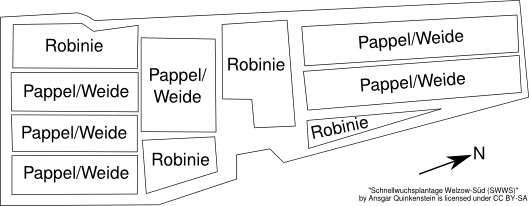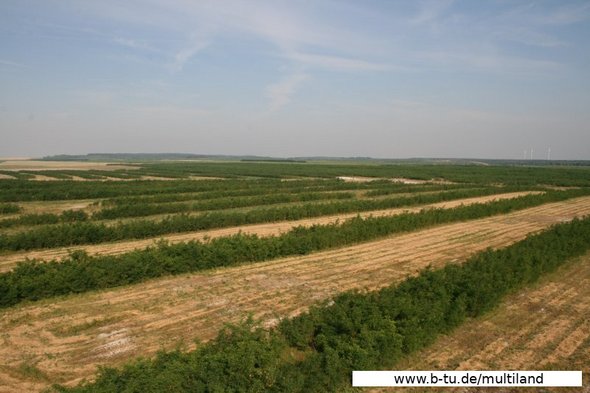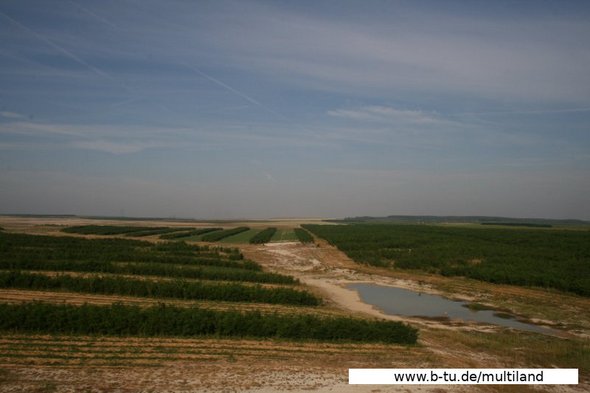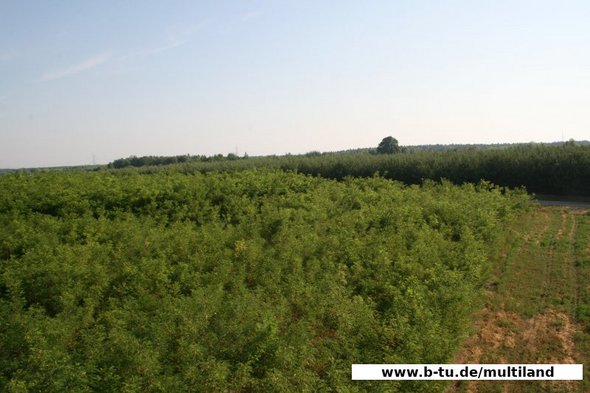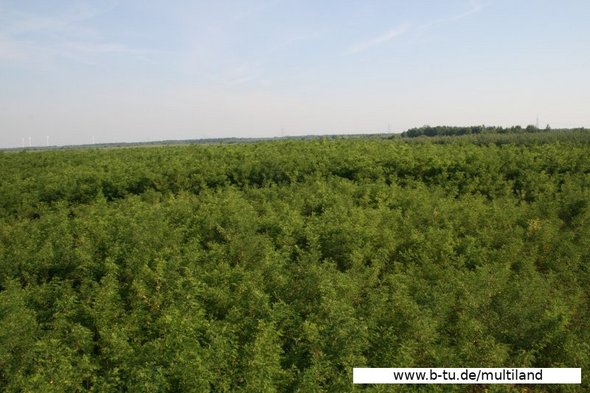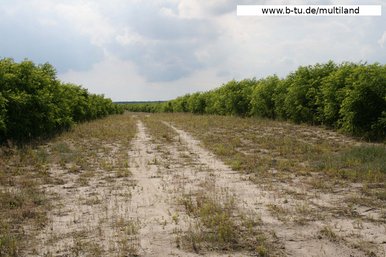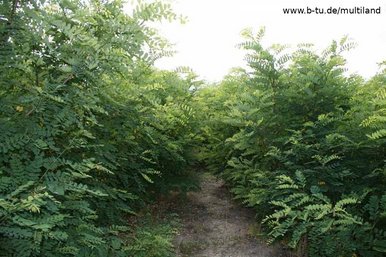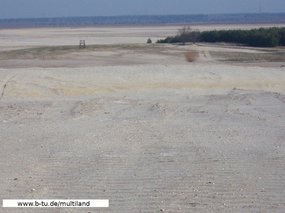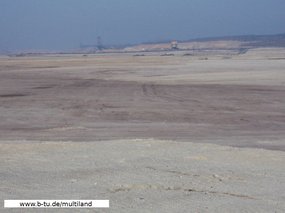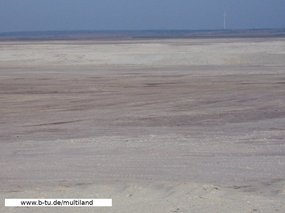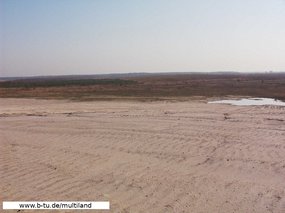Trials
In this section you’ll find a list of ongoing long-term field trails of our working group. Please choose the trail of interest from the menu on the left.
This agroforestry system was established in 2010 next to the city of Forst (Eastern Germany) in corporation with the Agrargenossenschaft Forst e.G. It covers an area of 70 ha.
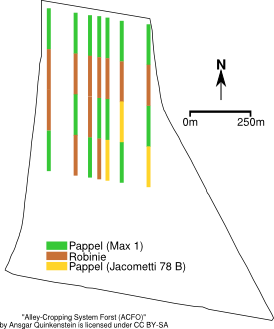
The system consists of seven tree strips (each strip has a width of 11m and consists of four double-rows, respectively) with a total length of 660 m, and a distance of 96 m, 48 m and 24m between the strips. The planted tree species were black locust (Robinia Pseudoacacia L.) and the poplar clones Max 1 and Jacometti 78B.
In 1996 a field trail of about 7 ha was established, located in the strip mine Jänschwalde in the Lusatia mining district. Here, it was possible to test the ability to adapt alley cropping as agroforestry land use system to climate and soil conditions in middle-Europe. The primarily focus laid on the sustainable production of woody biomass for energy production on poor agricultural sites.
The trail consisted of twelve tree rows of 6.1m width and 122.4 m length and a distance of 18 m to each other. They were planted perpendicular to the predominant wind direction and the direction of soil sediment strata originated from mining activities. Besides the tree specie black locust (Robinia Pseudoacacia L.), two poplar clones (Androscoggin and Hybride 275) and the willow clone Carmen were tested.
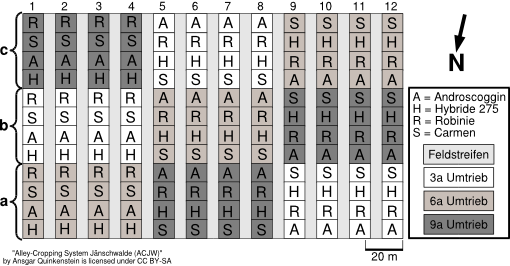
The field and laboratory trails were conducted between 1996 and 2007. They comprised a detailed site description, studies on growth, yield and plant nutrition of both, tree species and intercropped agricultural crops. Furthermore the interaction between the black locust and the fodder crop alfalfa (Medicago sativa L.) was investigated. The site was abandoned on 2007.
This field trail was established in spring 2007 and covers 7 ha of recultivated area in the strip mine Welzow-Süd in the Lusatia mining district. The site is part of the Energy landscape Welzow-Süd.
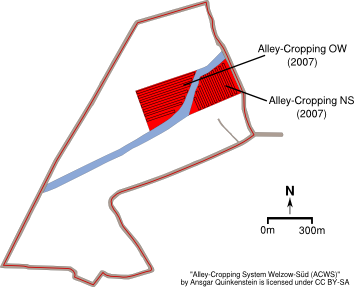
The alley cropping system consists of 12m wide tree rows with a spacing of 24 m used for crop production. The trail is divided in two parts, one with tree rows perpendicular to the predominant wind direction (4 double rows with black locust Robinia Pseudoacacia L.) and the second in wind direction.
The agricultural area between the tree strips is cropped with a mixture of alfalfa and grass, which is regularly mulched for soil improvement. It is planned to continue this cultivation for 3 years. This legumes rich mixtures will still play an important role in the crop rotation with winter rye and winter catch crops in the near future.
The following pictures show the alley cropping system in Welzow-Süd in summer 2010.
Die Erzeugung nachwachsender Rohstoffe für die stoffliche oder energetische Verwertung (Bioenergie-Produktion) gewinnt vor dem Hintergrund des prognostizierten Klimawandels zunehmend an Bedeutung.
Auf Rekultivierungsflächen im Tagebau Welzow-Süd werden daher in enger Zusammenarbeit mit der Vattenfall Europe Mining AG auf einer Fläche von rund 170 ha im Landschaftsmaßstab unter betriebswirtschaftlichen Bedingungen verschieden Anbaumethoden für nachwachsende Rohstoffe vergleichend untersucht. Auf Basis der laufenden wissenschaftlichen Untersuchungen sollen Konzepte entwickelt werden, die eine zukunftsfähige, nachhaltig ökonomische, ökologische und sozial verträglich Produktion nachwachsender Rohstoffe ermöglichen.
Die Energielandschaft befindet sich etwa 15 km südlich von Cottbus im Rekultivierungsbereichs des Tagebaus Welzow-Süd:
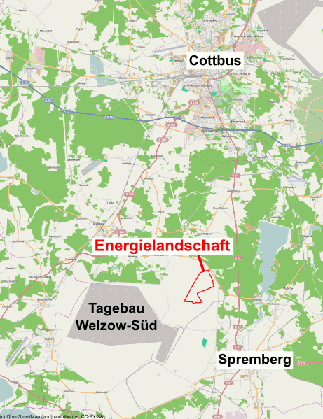
Konzeption
Es wird angestrebt zu überprüfen, inwieweit die bisherigen Ergebnisse zum Energieholzanbau in die Praxis übertragbar sind.
Dazu sollen Flächen mit schnellwachsenden Baumarten etabliert werden, auf denen eine wissenschaftlich begleitete Bewirtschaftung unter Praxisbedingungen erfolgt. Die größeren Flächen in der Energielandschaft werden in Eigenverantwortung von einem regionalen Landwirtschaftsunternehmen bewirtschaftet. Ziel ist es, eine nachhaltige wirtschaftliche Entwicklung über die Laufzeit des Vorhabens und darüber hinaus sicherzustellen. Die Abnahme der erzeugten holzartigen Biomasse wird unter Berücksichtigung der Wirtschaftlichkeit u.a. durch das Biomasseheizkraftwerk Neu-Haidemühl gewährleistet. Positiv im Sinne der Etablierung ist zudem die Übernahme von Anpflanzung und Jungbestandspflege für große Teilflächen im Rahmen der Rekultivierung durch die LMBV. Damit wird die gesamte Kette der Wertschöpfung von der Bereitstellung der Biomasse bis zu ihrer energetischen Verwertung abgedeckt.
Der Lehrstuhl für Bodenschutz und Rekultivierung der BTU Cottbus bringt seine Erfahrungen bei der Anlage, Pflege und Beerntung von schnellwachsenden Baumarten beratend in das Vorhaben ein. Er gibt Informationen zur Anbaueignung verschiedener Arten und Sorten schnellwachsender Baumarten, zur Eignung landwirtschaftlicher Kulturen für die Kombination mit schnellwachsenden Gehölzen in Agroforstsystemen sowie Empfehlungen zur Bewirtschaftung (Düngung, Bodenbearbeitung) und zu geeigneten Ernteverfahren. Dabei kann der Lehrstuhl für Bodenschutz und Rekultivierung auf seine umfangreichen Erfahrungen aus den bisher gemeinsam mit Vattenfall durchgeführten Forschungsvorhaben zurückgreifen. Weiterhin werden durch die beteiligten Partner Daten bereitgestellt, die für die Bewertung der Wirtschaftlichkeit des Anbaus schnellwachsender Baumarten relevant sind.
Zusätzlich ist es jedoch im Sinne der Vervollständigung von Beratungsinhalten für Land- und Forstwirte zwingend notwendig, in dem geplanten Vorhaben auch pflanzenernährungs- und ertragskundliche Daten zu erheben und in Beziehung zu den standörtlichen Bedingungen zu setzen. Diese grundlegenden Untersuchungen umfassen die Charakterisierung der standörtlichen Verhältnisse, Untersuchungen zu Pflanzenernährung und Düngung sowie zum Wachstum und der Ertragsbildung.
Projekte in der Energielandschaft Welzow
Die Anlage der Untersuchungsflächen begann 2005 mit Pflanzung der ersten Teilfläche des Energiewaldes Welzow-Süd (siehe Abbildung). Weitere Pflanzabschnitte folgten 2006 und 2007. Im gleichen Jahr wurden zwei Agroforstsysteme (ausgeführt als Alley-Cropping) etabliert. Seitdem kommen schrittweise weitere Untersuchungsflächen hinzu.
Detailliertere Informationen zu den einzelnen Versuchsflächen in der Energielandschaft Welzow und zu stattfindenen Forschungsprojekten können über das Menü aufgerufen werden.
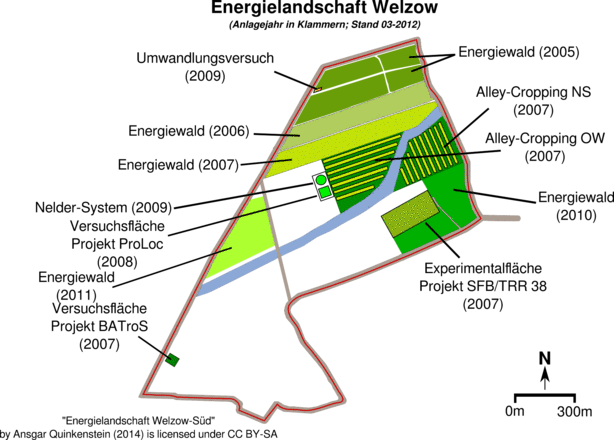
The Energy forest Welzow-Süd consists of multiple short rotation coppices and is part of the Energy landscape Welzow-Süd. The first trees were planted in 2005.
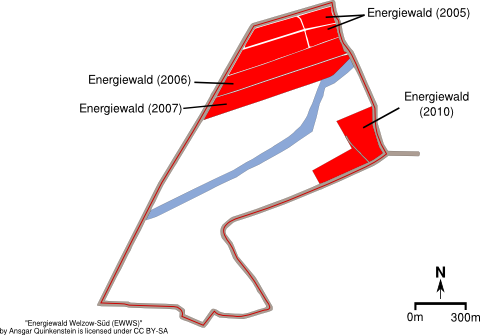
The coppices (figure below), which were planted between 2005-2007 and 2010, cover an area of in total 40 ha.
The average plant density is 9200 plants/ ha. Black locust (Robinia Pseudoacacia L.) was exclusively chosen as tree species due to its high yields in preliminary trails on similar sites. Harvests take place on a four to five year cycle.
Many research activities are taking place in this area. They comprised a site surveys, studies on plant nutrition and fertilization, growth and yield as well as analysis of the carbon cycle.
In 2009, the trees planted in 2005 were harvested the first time using a Claas Jaguar 870. The field conducted in 2007 followed two years later; harvested with a New Holland FR 9060equipped with a special attachment for short rotation coppices (KUP Vorsatz 130 FB).
In spring 2009 tails were conducted on a 6500 m² large area which was formerly used by the German Railways.
The 21 plots of various sizes (lengths between 18 and 28.5 m) were planted with fast growing species poplar (clone Hybride 275 and Muhle Larsen) and black locust. The trees were planted in rows with a distance of 0.75 m and 1.5 m spacing between the rows, using 5100 plants in total.
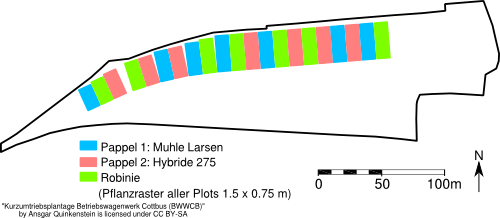
Die Versuchsflächen liegen auf einem ehemaligen Rieselfeld in Neuruppin, das von derGesellschaft zur Konversion im Ruppiner Land mbH in eine Demonstrationsfläche für nachwachsende Rohstoffe umgewandelt und nun betreut wird.
Auf den Parzellen 6 und 7 (siehe Abbildung) wurden im Jahr 2008 mehrere Parzellen mit Robinie (Robinia pseudoacacia L.) und Igniscum (Fallopia sachalinensis), auch bekannt als Sachalin-Staudenknöterich, bepflanzt.
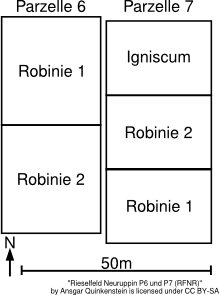
Die Parzelle 6 wurde hierzu in 2 Teilparzellen unterteilt, in denen jeweils 10 Reihen mit 31 Pflanzen (also insgesamt 310 Pflanzen pro Teilparzelle) gesetzt wurden. Verwendet wurden zwei Robinien-Herkünfte. Parzelle 7 wurde als Wiederholungsversuch zu Parzelle 6 angelegt, aber insgesamt in drei Teilparzellen unterteilt. Neben den gleichen Robinien-Herkünften wurde auch Igniscum in einer Teilparzelle ausgepflanzt.
Neben der turnusmäßigen Erfassung verschiedener Wuchsparameter laufen auf den Flächen auch Versuche zur Beurteilung der Schadstoff-Akkumulation in den Pflanzen (Stichwort Phytoremediation).
The Nelder system trail is a part of the Energy landscape Welzow-Süd and is purposed to analyses how variable plant densities, hence the space available for an individual tree, influence growth of single trees and the coppice as a whole. The species black locust and poplar (Hybride 275) were used. The plant density for the nearby Energiewald Welzow-Süd lies around 10000 plants/ha, following preliminary plans. However it is questionable if this plant density is the optimum for sustainable high yields.
In general, the analysis of the plant available space reveals which plant densities and strategy to thin the coppice are the best choice for optimal biomass production and carbon sequestration. Moreover, it can be shown how allometry and allocation in plants changes with different grades of competition.
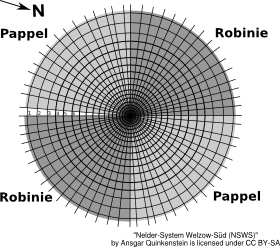
The figure above shows a sketch of the Nelder-System in Welzow-Süd comprising in total 1000 plants. Every line crossing in the sketch equals one plant. According to the radial scheme, the space between the rows is smallest in the center and getting wider towards the outer cycle.
The plantation was established in 1995 on a reclaimed site in the lignite opencast mine Welzow-Süd.
The aim of the research is to examine the growth performance of different fast growing trees on former lignite mine sites and under the harsh growth conditions in Lower Lusatia.
Clones of balsam poplar, willow, and aspen as well as black locust are tested.
